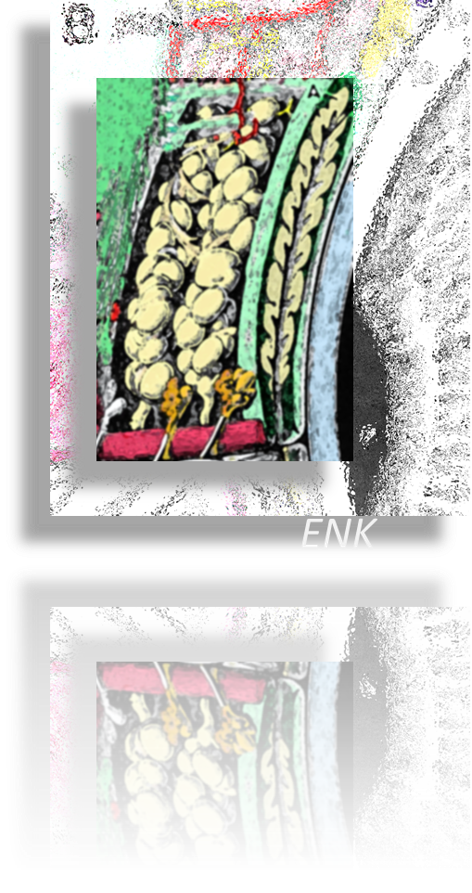DEEPER INSIGHT into …
HISTORY of the MEIBOMIAN GLANDS
The Meibomian Glands produce the lipids for the superficial layer of the tear film that is of utmost importance for the stability of the tear film as such and, on top, for providing its a smooth outer layer for perfect light refraction.
Since the pre-corneal TEAR FILM is the target of all functional aims of the ocular surface because it is indispensable to maintain the moisture of the mucosal surface and thereby the transparency of the cornea - everywhere & everytime - the importance of the Meibomian glands can thus not be overrated.
The tear film lipids are of critical importance for ocular surface Moisture and integrity
The production of the Meibomian lipids - provided by the integrity of the Meibomian glands seems to be the critical point for providing ocular moisture.
Even when there is intact aqueous secretion that can derive from different sources, as the main lacrimal gland, the accessory lacrimal glands, and also from an unknown contribution by direct water secretion of the conjunctival epithelial cells - this will quickly evaporate without the oily protection, in the dry environment on earth that we live in for the last roughly about 500 million years.
Therefore, it should have been no surprise, that Meibomian Gland Dysfunction (MGD) with a respective quantitative and/or qualitative deficiency of the lipids is the main causative factor for Dry Eye Disease.
The fact that MGD induces Dry Eye Disease - which is the prototypic ocular surface disease because it arises due to corruption of its basic function of moisture - gives more evidence that the ocular lipids are in a critical position for ocular surface integrity and that MGD is undermining the foundations of the ocular surface functional unit.
Heinrich Meibom was the first to describe the tarsal glands in some detail
The Meibomian Glands are named after Heinrich MEIBOM (1638-1700), a Professor for Medicine at the university town of Helmstedt in about the middle of Germany. He came from an important academic family apparently with best connections because he received his Professorship during his study time in Angers, France, when he had not even finished his doctorate. Some year later he also inherited the chairs for Philosophy and History that his grandfather, a famous historian and poet, had held before.
On the occasion of the 300th anniversary of his birthday, in 1938, the British Medical Journal characterized him as: “Like so many of his contemporaries, he was indeed a child of
Apollo, god of culture, poetry, rhetoric, and healing. ..[ Apart from Medicine ] .. He further showed his versatility by straying into the pleasant fields of archaeology,philology, and philosophy, and all his life he was an insatiate traveller.”
Heinrich Meibom did not discover the Meibomian glands but he was the first who dissect and described them in some detail in the year 1666. Apparently as a man of distinction, he did not give them his name but rather termed them, according to their location, as "Glandulae tarsales" or tarsal glands.
The Meibomian Glands were already known for a long time … but have ever since remained without much interest
These glands in the tarsal plates of both, the upper and lower eye lids were already known to GALEN from Pergamon (129-216) a Greek who became famous and popular in ancient Rome and was therefore also known by the name ´Clarissimus Galen´ - the ´most famous Galen´ - today he would probably be called ´THE´ Galen.
He used to perform public spectacular dissections of animals, often pigs, in Rome and was a multi-author of several eminent books that were ... before the advent of experimental approaches in medicine ... read and studied until the 19th century even though they contained several distinct errors ... that remained undiscovered since medical dissection was typically not allowed in the mean time.
The Egyptians may already have known the Meibomian Glands
... because they can develop an acute purulent painful inflammation, known as hordeolum or stye. This leads to swelling and redness of the outer eye lid and is quite obvious also to the layman. It may thus be assumed that already the Egyptians may have likely covered at least this disease condition in their codices.
Underestimation concerning the Meibomian Glands continued until the TFOS MGD Workshop Report in 2011
The fact that the Meibomian glands did not receive much interest, continued until quite recently. This may be because their oily lipid secretum does not seem to fit seamlessly into the context of the obviously aqueous tears. Also, even though their orifices are quite close to the posterior lid border - the orifices are not very obvious.
In about the middle of the 20th century, the three-layered tear film with a superficial lipid layer was described by WOLFF and later by MISHIMA and others. In the 1980s Jeff GILBARD had made several studies that showed the functional importance of the Meibomian Glands and the onset of hyper-osmolarity in the tears due to increased aqueous evaporation, when the glands were blocked.
Still, the great importance of the healthy Meibomian Glands for the integrity of the ocular surface or, reverse, their overwhelming importance for the development of Dry Eye Disease when they are dysfunctional, was not fully recognized before the TFOS MGD Workshop report.




